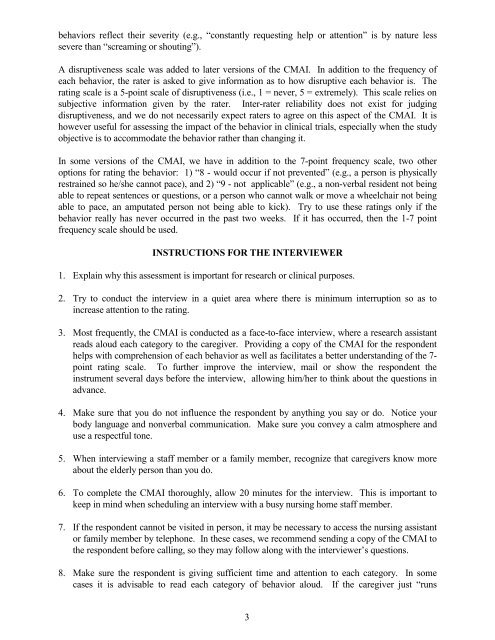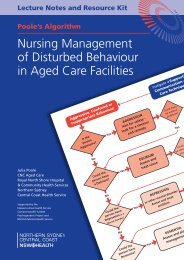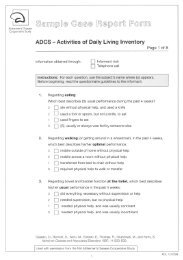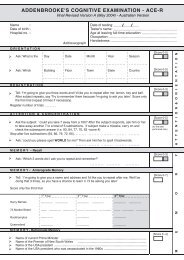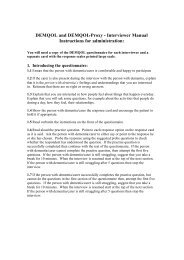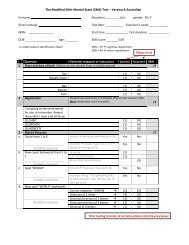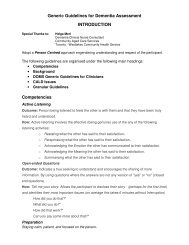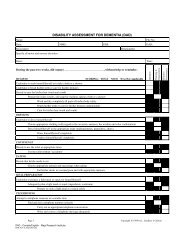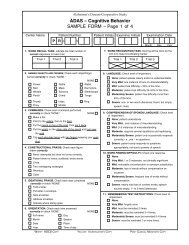Instruction manual for the cohen-mansfield agitation inventory
Instruction manual for the cohen-mansfield agitation inventory
Instruction manual for the cohen-mansfield agitation inventory
You also want an ePaper? Increase the reach of your titles
YUMPU automatically turns print PDFs into web optimized ePapers that Google loves.
ehaviors reflect <strong>the</strong>ir severity (e.g., “constantly requesting help or attention” is by nature less<br />
severe than “screaming or shouting”).<br />
A disruptiveness scale was added to later versions of <strong>the</strong> CMAI. In addition to <strong>the</strong> frequency of<br />
each behavior, <strong>the</strong> rater is asked to give in<strong>for</strong>mation as to how disruptive each behavior is. The<br />
rating scale is a 5-point scale of disruptiveness (i.e., 1 = never, 5 = extremely). This scale relies on<br />
subjective in<strong>for</strong>mation given by <strong>the</strong> rater. Inter-rater reliability does not exist <strong>for</strong> judging<br />
disruptiveness, and we do not necessarily expect raters to agree on this aspect of <strong>the</strong> CMAI. It is<br />
however useful <strong>for</strong> assessing <strong>the</strong> impact of <strong>the</strong> behavior in clinical trials, especially when <strong>the</strong> study<br />
objective is to accommodate <strong>the</strong> behavior ra<strong>the</strong>r than changing it.<br />
In some versions of <strong>the</strong> CMAI, we have in addition to <strong>the</strong> 7-point frequency scale, two o<strong>the</strong>r<br />
options <strong>for</strong> rating <strong>the</strong> behavior: 1) “8 - would occur if not prevented” (e.g., a person is physically<br />
restrained so he/she cannot pace), and 2) “9 - not applicable” (e.g., a non-verbal resident not being<br />
able to repeat sentences or questions, or a person who cannot walk or move a wheelchair not being<br />
able to pace, an amputated person not being able to kick). Try to use <strong>the</strong>se ratings only if <strong>the</strong><br />
behavior really has never occurred in <strong>the</strong> past two weeks. If it has occurred, <strong>the</strong>n <strong>the</strong> 1-7 point<br />
frequency scale should be used.<br />
INSTRUCTIONS FOR THE INTERVIEWER<br />
1. Explain why this assessment is important <strong>for</strong> research or clinical purposes.<br />
2. Try to conduct <strong>the</strong> interview in a quiet area where <strong>the</strong>re is minimum interruption so as to<br />
increase attention to <strong>the</strong> rating.<br />
3. Most frequently, <strong>the</strong> CMAI is conducted as a face-to-face interview, where a research assistant<br />
reads aloud each category to <strong>the</strong> caregiver. Providing a copy of <strong>the</strong> CMAI <strong>for</strong> <strong>the</strong> respondent<br />
helps with comprehension of each behavior as well as facilitates a better understanding of <strong>the</strong> 7point<br />
rating scale. To fur<strong>the</strong>r improve <strong>the</strong> interview, mail or show <strong>the</strong> respondent <strong>the</strong><br />
instrument several days be<strong>for</strong>e <strong>the</strong> interview, allowing him/her to think about <strong>the</strong> questions in<br />
advance.<br />
4. Make sure that you do not influence <strong>the</strong> respondent by anything you say or do. Notice your<br />
body language and nonverbal communication. Make sure you convey a calm atmosphere and<br />
use a respectful tone.<br />
5. When interviewing a staff member or a family member, recognize that caregivers know more<br />
about <strong>the</strong> elderly person than you do.<br />
6. To complete <strong>the</strong> CMAI thoroughly, allow 20 minutes <strong>for</strong> <strong>the</strong> interview. This is important to<br />
keep in mind when scheduling an interview with a busy nursing home staff member.<br />
7. If <strong>the</strong> respondent cannot be visited in person, it may be necessary to access <strong>the</strong> nursing assistant<br />
or family member by telephone. In <strong>the</strong>se cases, we recommend sending a copy of <strong>the</strong> CMAI to<br />
<strong>the</strong> respondent be<strong>for</strong>e calling, so <strong>the</strong>y may follow along with <strong>the</strong> interviewer’s questions.<br />
8. Make sure <strong>the</strong> respondent is giving sufficient time and attention to each category. In some<br />
cases it is advisable to read each category of behavior aloud. If <strong>the</strong> caregiver just “runs<br />
3


